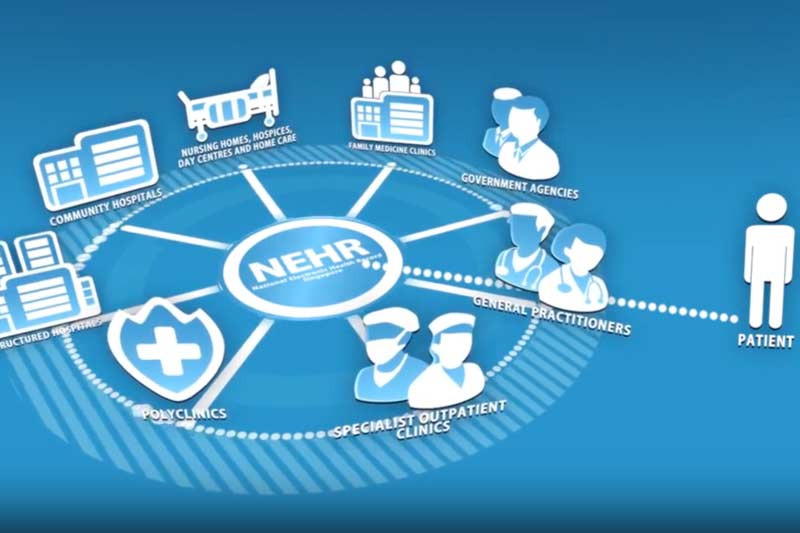
The Minister for Health, Mr. Gan Kim Yong, announced today that several support initiatives will be introduced to encourage healthcare licensees to contribute data to the National Electronic Health Record (NEHR). Over 4,000 licensees will be eligible for the support initiatives, which includes sharing of technical and clinical expertise through workshops and online resources, as well as financial support. Workshops and technical support would also be provided to IT vendors who provide clinic management or medical record software.
Implemented by the Integrated Health Information Systems (IHiS), Singapore’s health technology agency, the support initiatives are part of larger efforts to achieve the Ministry of Health’s (MOH) “One Patient, One Health Record” vision to enhance continuity of care and patient safety, especially during emergencies.
During his address at Future Health 2017 this morning, Minister Gan shared MOH’s plan to make data contribution to the NEHR mandatory for all healthcare licensees under the new Healthcare Services Bill. This move is necessary to build comprehensive electronic health records for each patient in Singapore, to enable better integrated care across healthcare providers. This would improve patient care and safety as healthcare providers will be alerted to key patient information such as allergies and current medication, and enable timely decision making in emergency situations.
A/Prof Low Cheng Ooi, Chief Medical Informatics Officer at MOH and Chief Clinical Informatics Officer at IHiS, shared: “With a growing ageing population and increase in chronic diseases together with multiple comorbidities, more patients are visiting multiple care providers for varying needs. As our healthcare landscape evolves, it is important for clinicians to obtain a view of their patients’ medical history from the NEHR to make better-informed diagnoses and treatment decisions. During emergencies, it could also save lives. Hence, contribution of quality data from all healthcare providers is an important step towards achieving safer and more effective care for our patients.”
Mr. Bruce Liang, Chief Information Officer at MOH and Chief Executive Officer at IHiS, added: “This will not be an easy journey. The state of IT adoption is uneven across the 4000 over healthcare institutions in Singapore and there is a large number of IT solution providers with wide variation of offerings. As such, we expect challenges in on-boarding all licensees to the NEHR. However, it is a journey we must make as a strong digital backbone is essential in meeting our patients’ and healthcare system’s needs in the future.”
Since 2011, IHiS has on-boarded public healthcare institutions to the NEHR. In the last few years, IHiS has also worked with private primary, acute, intermediate and long term care providers and IT solution providers in numerous IT enablement projects. Mr. Liang added: “We hope to leverage this experience to guide all licensees and their IT solution providers throughout this journey.”
The initiatives for healthcare licensees comprises sharing of clinical and technical expertise, and financial support:
1) Clinical expertise: Workshops for licensees will be held from early 2018 to provide guidance on the various clinical standards and requirements for data contribution and the process to meet them, address their queries as well as collect further feedback from them. Online support resources at www.ihis.com.sg/connectnehr will also be available to provide information on the NEHR, its benefits on how it enables licensees to better care for patients, various schemes and support available to licensees, and a dedicated contact number (available during business hours) and email for licensees to seek assistance.
2) Technical expertise: Workshops, technical advisors and tools would be made available to IT solutions providers who provide clinic management and/or medical record software. This will help them understand the technical and security requirements and enable connections to the NEHR. In turn, the vendors would be able to better support licensees to achieve early data contribution.
3) Financial support: An Early Contribution Incentive scheme totaling some S$20million would be available to licensees who are using, or planning to use non-MOH funded IT systems, if they start data contribution by June 2019. The incentives are designed to help defray costs that would be incurred to enhance IT system capabilities for contribution. Funds would be disbursed to licensees after they start contributing the required quality data for at least three months. Licensees can express their interest to participate in the scheme from 8 November 2017 at www.ihis.com.sg/connectnehr.
Data contribution to the NEHR is currently voluntary for all private healthcare licensees. Since early 2017, discussions with licensees and various professional bodies and associations have been ongoing to better understand their needs and provide relevant support and assistance. For an overview of the NEHR, refer to the video by IHiS below:
Members of the public can find out more information on how they benefit from the NEHR, view patient FAQs, and share their views on the NEHR in a public survey at www.ihis.com.sg/nehr .
















